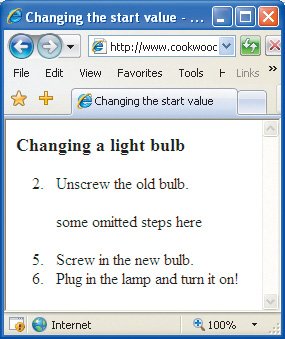Choosing Where to Start List Numbering
| You might want to start a particular ordered list's numbering somewhere other than 1 (which is the default). To determine the initial value of an entire list's numbering scheme: Within the ol tag, type start="n", where n represents the initial value for the list. To change the numbering of a given list item: In the desired li item, type value="n", where n represents the value for this list item. The value is always specified numerically and is converted automatically by the browser to the type of marker specified with CSS or with the type attribute (see page 218).
Figure 15.8. In this example, I've omitted some steps but want to maintain the original numbering. So I start the whole list at 2 (with start="2") and then set the value of the third item to 5 (with value="5"). Figure 15.9. Notice that not only are the first and third items numbered as we've specified, but the third item ("Plug in the lamp") is also affected. |
EAN: 2147483647
Pages: 340
 Tips
Tips
